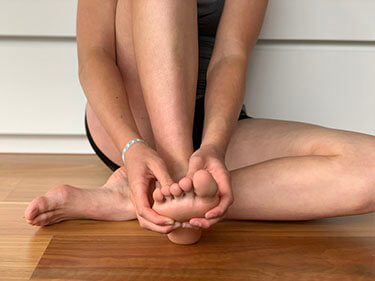BLOG
Foot Pain – a pain that is not to be ignored



A pain in ones foot can start off as a small discomfort but after a day of walking, jogging, or even standing in high heels, a small issue can become a big problem. Foot pain can be divided into 3 categories; local musculoskeletal pain, referred musculoskeletal pain and pain related to chronic disease or pathology.
Local musculoskeletal pain is often due to injury on or around the foot. This type of pain occurs when it is obvious you have injured your foot, and whether or not you seek treatment will depend on a few factors. As a general rule if your injury is significant enough that it causes you pain in walking you should see a professional for an assessment. Once your gait is impaired and causes you to limp, it is best to identify the cause of this issue and rectify it as soon as possible. An altered gait pattern can have undesirable knock on effects to other parts of the body.
Additionally, it is advisable to seek a professional opinion if you have any of the following symptoms; significant swelling that comes on shortly after injury, redness and heat, sharp pain that may be suggestive of a fracture, pain that wakes you in the night, or you have an inability to weight bear at all.
If there was no traumatic event that brought on your pain but rather it gradually increased over time, the same rules apply. If you have pain when walking or any of the above symptoms, it is advisable to have an assessment sooner rather than later. It is preferable to address chronic disease processes early. The further they progress, the harder and more complex they can be to correct.
Referred musculoskeletal pain means the pain originates in another part of the body. This is where it gets tricky. The body is a complex thing, and it is possible to have foot pain that is referred from, or related to other parts of the body. This may be from structures further up your leg, from your back, or possibly even from your neck. How can this be the case? Your body will perceive foot sensation/pain when a nerve that supplies your foot is activated. This may be from local structures in the foot, but this sensation can also be experienced when the nerve that supplies the foot is stretched or compressed down the pathway from your brain. A common place this occurs is at the point where the nerves exit through the lower back also known as nerve root compression. It can also happen at points where the nerve passes close to or through another structure, such as a muscle or bone.
If you are unable to locate your pain and evoke it by touch or movement of your foot alone, then it is possibly referred pain. As there are multiple possible causes of your pain, only a professional should advise you on this.
Additionally, local injuries to the foot can then cause pain further up the leg segment. For example, limping on a sore foot can cause secondary issues in your glutes. Correcting an impairment further up your leg, such as improving the strength in your glutes, can reduce the load on your sore or weak foot.
Foot pain related to chronic disease or pathology rarely occurs and is not something that we want to overlook. Typically, foot pain is the result of an issue with your foot. Very occasionally, a different type of issue can mimic common conditions and behave like a general musculoskeletal injury. The symptoms you might experience include swelling, changes in sensation, or a simple pain in your foot. There are too many examples to cover here, but some possible causes include vascular issues, cardiac issues, cancer, neurological disease, and other systemic diseases. Your health professional will ask you a series of very specific questions to help rule these out giving us confidence with our diagnosis.
If we have any concerns with your pattern of symptoms or want some extra assurance that any of the above is not a potential explanation for your issues, we will discuss this with you first and refer you to either your GP or another relevant clinician for further assessment.
Anyone can experience foot pain in their lifetime. Your physiotherapist can do the detective work to help find the real source of your pain, and get you back on your feet promptly.
Published December 10, 2019